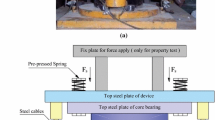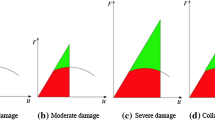Abstract
Earthquake is a complex multi-dimensional excitation. Counter-measures of such multi-dimensional excitation on many critical structures, such as long-span structures and high-rise buildings, must be taken into account to avert the structural failure. Many types of earthquake mitigation or isolation devices for mitigating earthquake-induced effects in the horizontal direction have been proposed and applied to real applications. However, study on multi-dimensional earthquake isolation and mitigation devices for structures has been received much less attention. In this paper, a new multi-dimensional earthquake isolation and mitigation device was developed and tested. Effects of excitation frequency and environmental temperature on horizontal properties of this device were considered. At the same time, fatigue properties of the device under different amplitude horizontal excitations were also studied experimentally. The equivalent standard solid model which can effectively describe the effect of frequency and temperature on the horizontal properties of the device was proposed and verified. From the experimental results, it may be concluded that the multi-dimensional earthquake isolation and mitigation device owns fine energy dissipation and fatigue resistance capabilities.
Similar content being viewed by others
References
Chang K C, Soong T T, Oh S T, et al. Effect of ambient temperature on a viscoelastically damped structure. J Struct Eng, ASCE, 1992, 118: 1955–1973
Kasai K, Munshi J A, Lai M L. Viscoelastic damper hysteretic model: Theory, experiment and application. In: Proc ATC 17-1 on Seismic Isolation, Energy Dissipation and Active Control, San Francisco, 1993. 521–532
Tsai C S. Temperature effect of viscoelastic dampers during earthquakes. J Struct Eng, ASCE, 1994, 120: 394–409
Shen K L, Soong T T. Modeling of viscoelastic dampers for structural application. J Eng Mech, ASCE, 1995, 121: 694–701
Inaudi J A. Time-domain analysis of linear hysteretic damping. Earthq Eng Struct Dyn, 1996, 25: 529–545
Lee D G, Hong S, Kim J. Efficient seismic analysis of building structures with added viscoelastic dampers. Eng Struct, 2002, 24: 1217–1227
Xu Z D, Shen Y P, Zhao H T. A synthetic optimization analysis method on structures with viscoelastic dampers. Soil Dyn Earthq Eng, 2003, 23: 683–689
Hwang J S, Wang J C. Seismic response prediction of HDR bearings using fractional derivative Maxwell model. Eng Struct, 1998, 20: 849–856
Xu Z D. Experiment and Study on the (Lead) Viscoelastic Structures. Dissertation of Doctoral Degree. Xi’an: Xi’an Archt and Techn Univ, 2001
Suhara J, Okada Y, Tamura T, et al. Development of three dimensional seismic isolation device with laminated rubber bearing and rolling seal type air spring. ASME, PVP, 2002, 445: 43–48
Xiong S S. Theoretical and Experimental Research of Three-Dimensional Seismic Base Isolation System (in Chinese). Dissertation of Doctoral Degree. Wuhan: Huazhong University of Science and Technology, 2004
Meng Q L, Lin D Q, Zhang M Z. Study on three-dimensional isolated system in shaking table test (in Chinese). J Earthq Eng Eng Vibr, 2007, 27: 116–120
Wei L S, Zhou F L, Ren M, et al. Application of three-dimensional seismic and vibration isolator to building and site test (in Chinese). J Earthq Eng Eng Vibr, 2007, 27: 121–125
Zhao Y M, Su J Y, Zhou X Y. Shaking table test and numerical analysis of vertical-isolated building model with combined disk spring bearing (in Chinese). J Build Struct, 2008, 29: 99–106
Kim J K, Ryu J G, Chung L. Seismic performance of structures connected by viscoelastic dampers. Eng Struct, 2006, 28: 183–195
Bilbao A, Aviles R, Agirrebeitia J, et al. Proportional damping approximation for structures with added viscoelastic dampers. Finite Elements Analysis Design, 2006, 42: 492–502
Ferry J D. Viscoelastic Properties of Polymers. 3rd ed. New York: Wiley, 1980
Lai M L, Lu P, Lunsford D A, et al. Viscoelastic damper: A damper with linear or nonlinear material. In: 11th World Conference on Earthq Eng, Acapulco, Mexico, 1996
Tezcan S S, Uluca O. Reduction of earthquake response of plane frame buildings by viscoelastic dampers. Eng Struct, 2003, 25: 1755–1761
Drozdov A D. Viscoelastic Structures. Elsevier, 1998
Author information
Authors and Affiliations
Corresponding author
Rights and permissions
About this article
Cite this article
Xu, Z., Zeng, X., Huang, X. et al. Experimental and numerical studies on new multi-dimensional earthquake isolation and mitigation device: Horizontal properties. Sci. China Technol. Sci. 53, 2658–2667 (2010). https://doi.org/10.1007/s11431-010-4051-z
Received:
Accepted:
Published:
Issue Date:
DOI: https://doi.org/10.1007/s11431-010-4051-z




